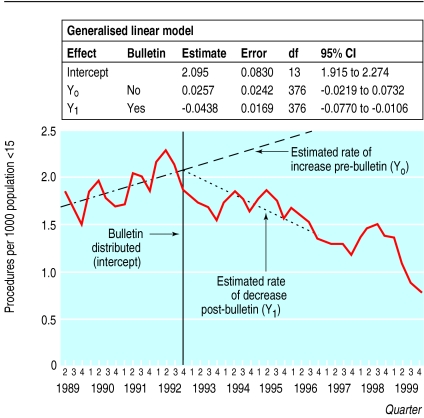During the 1980s, surgery for chronic otitis media with effusion (glue ear) increased greatly without obvious reason.1 “Dry taps”—absence of effusion upon incision—were common, probably because the surgery was performed without the surgeon confirming that the condition had not already resolved.2 An Effective Health Care bulletin on the treatment of persistent glue ear in children was distributed nationally to NHS decision makers in 1992.2 Based on systematic review, the bulletin concluded that surgery should be restricted to children with an extended period of substantial hearing impairment, with persistence and severity established by watchful waiting. We evaluated surgery rates before and after distribution of the bulletin.
Methods and results
Quarterly numbers of D151 procedures—insertion of a ventilation tube through the tympanic membrane—performed in children aged under 15 in England from 1989 to 1996 were obtained from the hospital episodes system. We calculated per capita regional and national rates for this procedure.3
We applied a generalised linear model with a heterogeneous first order autoregressive structure and repeated measures by region. The effect of the introduction of the bulletin was nested into the model using ‘proc mixed’ in SAS version 8 (SAS Institute, Cary, NC). This approach consistently identifies the best autoregressive structure (the model adjusts for the relatedness of sequential observations over time). We investigated regional variations in surgical rates by comparing standard error terms from the model before and after distribution of the bulletin. Overall, the model included data from 14 regions, each of which provided results from 28 quarters, half before and half after distribution of the bulletin.
In 1992, 77 766 grommet insertions were conducted; this was equivalent to a quarterly rate of 2.1 per 1000 children, with regional rates varying by a factor of two. A small increase in the quarterly rate of procedures per 1000 children during the three years before distribution of the bulletin (0.026 (95% confidence interval −0.022 to 0.073)) became a decrease in the four years after publication (−0.044 (−0.080 to −0.011); P<0.0001) (figure). The decrease in quarterly rate from 1992 onwards was seen consistently across the regions.
The changing trend in surgery suggests that 89 800 procedures were avoided nationally in the four years after the bulletin, providing a theoretical saving of £27m at 1992-3 prices.2 Regional variations in the numbers of surgical procedures undertaken were 30% smaller after distribution of the bulletin than before (SE 0.0169 v 0.0242). Our findings were not substantially altered by analysing procedures under the broader code D15 (drainage of the middle ear) or by age range.
Comment
Distributing printed recommendations to decision makers may influence surgery rates, since a trend towards a reduction in the number of grommet operations was seen after distribution of the bulletin. Rates for tonsillectomy—another elective procedure in the same specialty—increased steadily over the same period, suggesting that the change was specific to persistent glue ear and thus was related to the bulletin.
The change cannot be attributed to the bulletin alone, which was commissioned because of pre-existing concerns about appropriate use of the procedure. Its publication received coverage in the medical and academic press,4 possibly encouraging doctors to examine their own practices and bring about behavioural change.
Surgery rates were reduced, and there was an apparent improvement in the equality of care, but our results do not provide information on quality of care delivered by either general practitioners or surgeons. Adherence to watchful waiting principles may have promoted more appropriate (and reduced) patient selection; alternatively, primary care physicians alerted by media concerns may have reduced referral rates. Establishing the link between health service activity and quality of care remains difficult.
The estimated savings from reduced surgery (£27m) are considerably greater than the approximate production cost of the bulletin (£25 000). Another bulletin addressing the prescribing of selective serotonin reuptake inhibitors demonstrated a similar profile of costs.5 Although the apparent healthcare savings are impressive, the impact on health outcomes, costs of alternative care received by patients, and costs of other health promoting activities remain unknown.
Figure.
Quarterly rate of grommet insertions for glue ear per capita in England before and after distribution of the Effective Health Care bulletin on treatment of persistent glue ear
Footnotes
Funding: Academic grant from Nuffield Trust for Research Policy Studies in Health Services, registered charity No 209201.
Competing interests: JM and NF were members of the research team that wrote the Effective Health Care Bulletin on the treatment of persistent glue ear in children, and GB was a specialist adviser to the research team. JM and NF were employees of the Universities of York and Leeds, respectively, which received funding for the Effective Health Care bulletin project from the Department of Health.
References
- 1.Black NA. Surgery for children—a modern epidemic. Lancet. 1984;i:835–837. doi: 10.1016/s0140-6736(84)92280-3. [DOI] [PubMed] [Google Scholar]
- 2.The treatment of persistent glue ear in children. Effective Health Care 1992; No 4.
- 3.Department of Health. Health and personal social services statistics for England. London: HMSO; 1996. [Google Scholar]
- 4.Sheldon TA, Freemantle N, Browning GG, Maw AR, Mason JM, Song F. Glue ear guidelines: time to act on the evidence. Lancet. 1992;340:1324–1325. [PubMed] [Google Scholar]
- 5.Mason J, Freemantle N, Young P. The effect of the distribution of Effective Health Care Bulletins on prescribing selective serotonin reuptake inhibitors in primary care. Health Trends. 1998-9;30:120–122. [Google Scholar]



